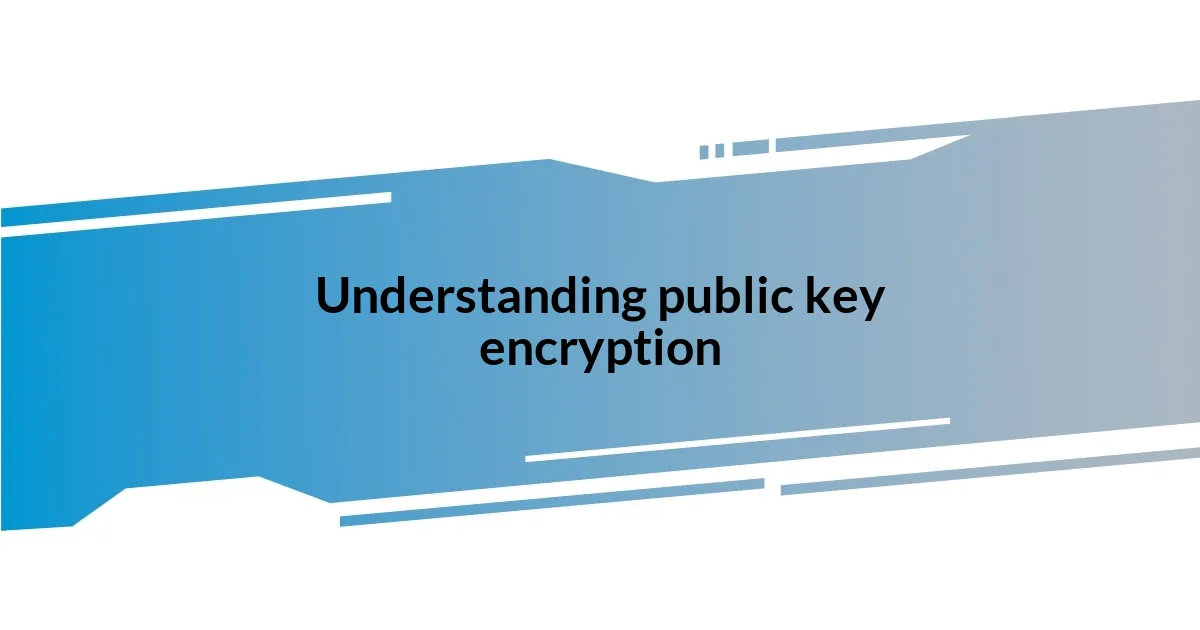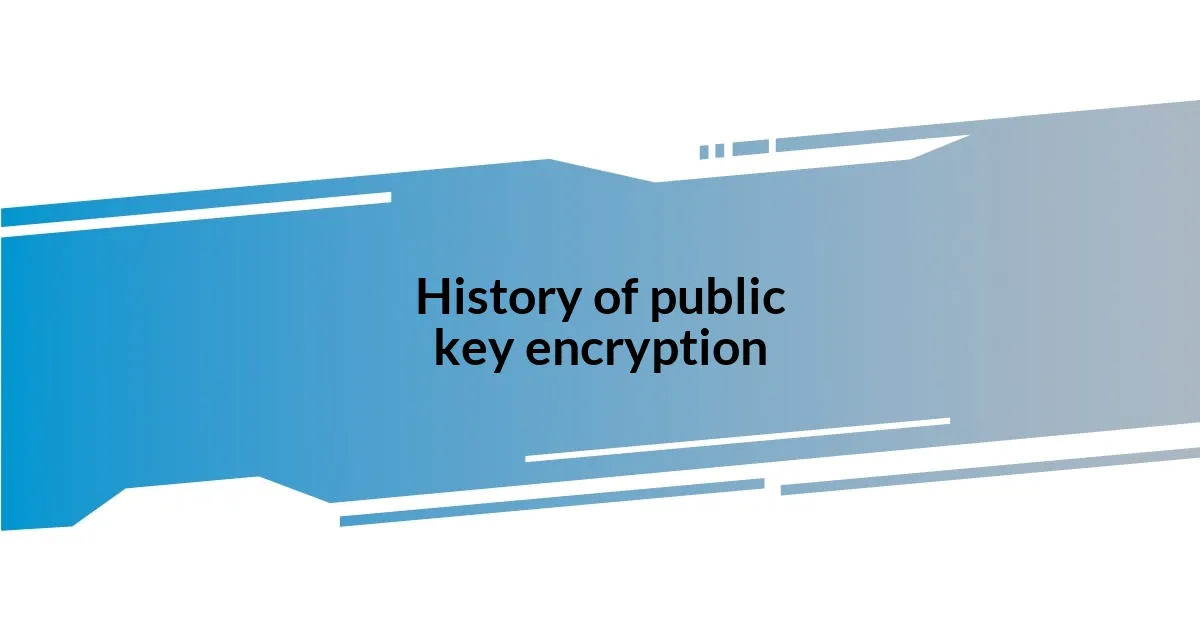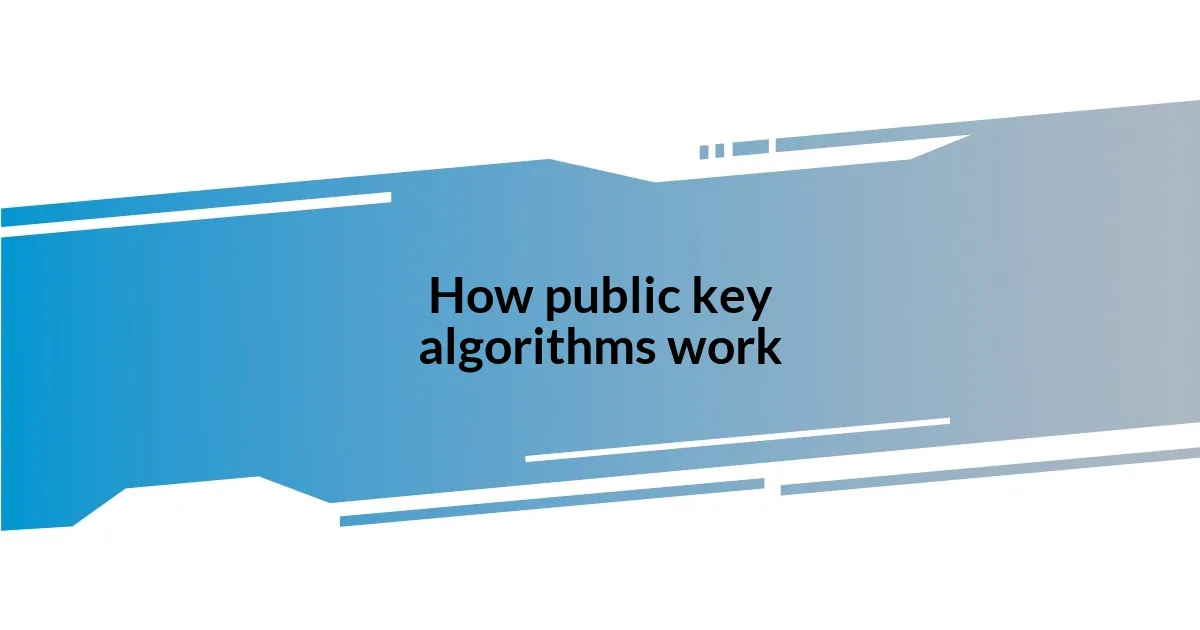Key takeaways:
- Public key encryption, introduced by Diffie and Hellman in 1976, allows secure communication using a public and private key system, enhancing digital security.
- The RSA algorithm, developed in 1977, was the first practical implementation of public key encryption, utilizing large number factorization for security.
- Challenges in public key encryption include key management complexities, vulnerabilities to advanced computing threats, and a general lack of user understanding.
- The emergence of PGP in 1991 significantly popularized public key encryption, bringing it to everyday users and enhancing digital privacy.

Understanding public key encryption
Public key encryption, also known as asymmetric encryption, is a method that uses two keys: a public key and a private key. The beauty of this system is that anyone can use the public key to encrypt a message, but only the person with the private key can decrypt it. I vividly remember the first time I wrapped my head around this concept—it’s like sending a locked box through the mail; everyone can put things in, but only you have the key to open it.
What strikes me about public key encryption is its ability to secure our conversations in a world where breaches are all too common. I recall feeling relieved when I learned that tools like this shielded my personal messages, like a protective cloak in a digital realm filled with potential threats. Isn’t it comforting to know that our private thoughts can be kept safe from prying eyes?
One aspect that often gets overlooked is the trust involved in sharing public keys. When I first started using this technology, I wondered how I could be sure that the key I received truly belonged to the intended person. This experience led me to appreciate the significance of key verification methods, like digital signatures, which ensure that the keys I use truly belong to my friends or colleagues. Public key encryption isn’t just about the technology—it’s also about the trust and relationships we build in our digital interactions.

History of public key encryption
The origins of public key encryption trace back to the 1970s, a time of great innovation in computer science and cryptography. I remember reading about how Whitfield Diffie and Martin Hellman introduced the concept in their groundbreaking paper in 1976. Their work was revolutionary because, for the first time, they presented a way to securely exchange keys without needing to meet in person, which feels quite futuristic, doesn’t it?
Here are some key milestones in the history of public key encryption:
- 1976: Diffie and Hellman publish their paper, laying the groundwork for public key cryptography.
- 1977: RSA, the first practical public key encryption algorithm, is introduced by Ron Rivest, Adi Shamir, and Leonard Adleman. I still find it impressive how this approach utilized factorization of large numbers for security.
- 1980s: Public key infrastructure (PKI) develops, enabling a framework for managing keys and certificates.
- 1991: The introduction of PGP (Pretty Good Privacy) by Phil Zimmermann brings public key encryption to the masses, sparking widespread interest among everyday users, which I find particularly inspiring.
Reflecting on these developments, I can’t help but appreciate how far we’ve come. Public key encryption has become an essential part of our digital lives, allowing us to communicate securely and trustingly.

How public key algorithms work
Public key encryption is really fascinating because it relies on complex mathematical principles to function. When a message is encrypted, it uses the recipient’s public key, transforming the information into a form that can’t be read without the corresponding private key. I remember the moment when I first grasped this idea—it felt like learning a secret language that only I and my friend could understand, a mix of excitement and security flooding over me.
The way public key algorithms operate is like a two-part puzzle. For instance, one part generates a key pair: a public key for encrypting data, and a private key for decrypting it. I can’t help but think of it as crafting a beautifully ornate box; while anyone can admire the outside and place a note inside, only the creator possesses the unique key to unlock it and reveal the message contained within. This imagery resonates with me because it highlights the artistry and craft behind encryption.
To illustrate the difference between public key and symmetric encryption, I find it helpful to compare their key characteristics. While symmetric encryption uses the same key for both encryption and decryption, public key encryption operates on a two-key system, enhancing security. Reflecting on this has deepened my appreciation for the necessity of both methods in our increasingly digital world.
| Feature | Public Key Encryption | Symmetric Encryption |
|---|---|---|
| Key Type | Two keys (public and private) | Single key |
| Security | Higher, due to key complexity | Lower, requires secure key sharing |
| Encryption Speed | Slower | Faster |
| Typical Use | Secure communications | Data encryption |

Challenges in public key encryption
Navigating the world of public key encryption isn’t without its hurdles. One significant challenge stems from the complexity of managing key pairs. I often think about the frustration I’ve felt when trying to organize my digital life; when keys get lost or mismanaged, it poses real security risks. Have you ever mislaid something important and felt that nagging anxiety? Losing a private key can leave encrypted data stranded, essentially locking it away forever.
Another concern is the potential for vulnerabilities in the algorithms themselves. While the mathematics behind public key encryption is robust, it’s not infallible. I can’t shake the unease that comes when I read about advances in computing power that could potentially crack even the strongest systems. For instance, the rise of quantum computing presents a theoretical threat to current encryption methods, making me wonder how secure our communications truly are in the long run.
Lastly, there’s the issue of user trust and understanding. I remember a time when I tried explaining public keys to a friend who was completely baffled. It’s clear that for many, the nuances of encryption remain a mystery, creating roadblocks to broader adoption. How can we expect people to use such powerful tools if they don’t grasp their significance? This realization drives home the need for better education and resources in this field.